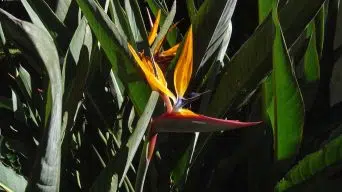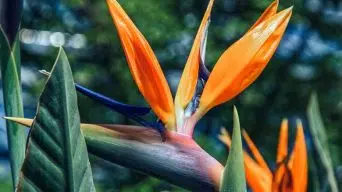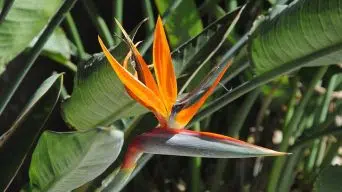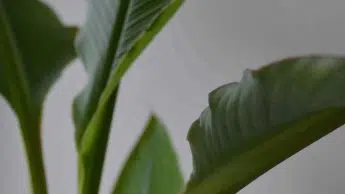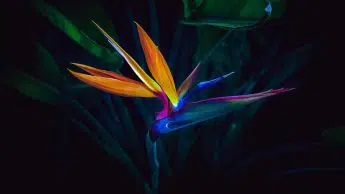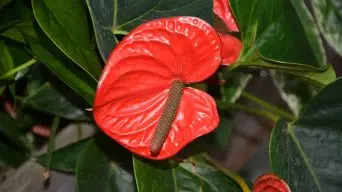Brown spots on Bird of Paradise may indicate a fungal infection, watering issues, direct sunlight damage, or pest infestation. To treat fungal diseases, use a fungicide spray. Overwatering and excess moisture should be avoided. Proper care is crucial for plant health.
Bird of Paradise plants, with their vibrant and exotic flowers, are popular for indoor and outdoor settings.
However, brown spots on these beautiful plants can cause concern among plant owners.
Here we’ll explore the common causes of brown spots on Bird of Paradise plants and offer practical solutions to keep your paradise plant looking its best.
Causes Of Brown Spots On Bird Of Paradise Plants
Bird of Paradise plants are a popular choice for indoor and outdoor decor. Still, they are prone to developing brown spots on their leaves, which can be a sign of various issues.
Fungal infections, overwatering or underwatering, exposure to direct sunlight, and pests are some common culprits behind these spots.
Understanding the causes behind brown spots on Bird of Paradise plants is crucial for their proper care and maintenance.
Fungal Infections
Fungal infections commonly cause brown spots on Bird of Paradise plants.
One such infection is gray mold, which typically results from excess moisture and can lead to unsightly blemishes on your plant’s vibrant leaves, which may also develop white spots.
In addition to gray mold and pythium root rot, bacterial wilt, and botrytis blight may also plague your bird of paradise.
Both result from poor drainage or overwatering, turning the once radiant leaves into a patchwork of brown spots.
Lastly, Armillaria root rot can harm your plant by invading its roots through the soil it grows in.
Overwatering Or Underwatering
Overwatering or underwatering are common causes of brown spots on Bird of Paradise plants.
Finding the right balance for these tropical beauties to thrive is crucial.
Overwatered paradise plants tend to be weak, leading to an increased susceptibility to diseases and pests like leaf spot diseases that create unsightly brown spots on the leaves.
On the other hand, underwatering your Bird of Paradise plant can also result in brown spots and curled leaves.
When starved for water, these plants become stressed and unable to absorb enough moisture through their roots.
To address this issue effectively, carefully monitor your plant’s soil: ensure it remains evenly moist but not saturated during the growing season while allowing it to dry out slightly between watering sessions in cooler months.
Exposure To Direct Sunlight
Exposure to direct sunlight plays a significant role in the development of brown spots on bird of paradise plants.
While these tropical beauties thrive with bright light, high-intensity direct sun can harm their delicate leaves.
Be mindful of its positioning within your home or garden to keep your Strelitzia reginae or white bird healthy and vibrant.
Place your crane flower in an area where it receives bright but indirect light for the best results.
Consider adding shade structures like umbrellas or taller plants for outdoor plants to protect against the harsh midday sun.
Alternatively, move indoor Birds of Paradise away from windows receiving intense sunlight throughout the day.
Pests
Birds of paradise plants are susceptible to a variety of pests that can cause brown spots on the leaves.
Whiteflies, aphids, and spider mites are common culprits that feed on the sap of these plants and leave behind a trail of damage.
These pesky insects cause unsightly spots and weaken the plant’s overall health.
It’s worth noting that high humidity levels can attract spider mites and other pests to your indoor bird of paradise plant.
Additionally, mulching around outdoor plants can provide an ideal breeding ground for various insects.
Solutions To Brown Spots On Bird Of Paradise Plants
If you have noticed brown spots on your Bird of Paradise plant, don’t worry; several solutions exist.
Fungal infections can be treated with fungicides. Proper watering habits, adequate light, and pest control measures like insecticidal can also help combat brown spots.
Following these solutions can restore your plant’s health and beauty.
Treating Fungal Infections
If fungal infections cause brown spots on your bird of paradise plant, there are several solutions that you can try:
- Apply soil sulfur: This will acidify the soil and kill the fungus in the roots. Follow the instructions on the package for application rates.
- Fungicide treatment: There are several fungicides available that can be used to treat fungal infections in plants. Be sure to choose one that is safe for use on bird of paradise plants and follow the instructions carefully.
- Remove affected leaves: Depending on the infection’s severity, removing any affected leaves from your bird of paradise plant may be necessary to prevent the further spread of the fungus.
- Improve air circulation: Good air circulation around your plant can help prevent fungal infections by reducing humidity levels and preventing moisture buildup.
Remember, prevention is always better than cure for plant diseases.
Ensure that you are providing adequate drainage and avoiding overwatering, keeping your plant healthy with proper fertilization, and promptly addressing pest infestations to keep it healthy and free from brown spots caused by fungal infections.
Adjusting Watering Habits
If you notice brown spots on the leaves of your Bird of Paradise plant, it could be due to overwatering or underwatering.
Here are some tips for adjusting your watering habits to prevent brown spots:
- Check the soil moisture: Before watering your plant, check the soil’s moisture level by sticking your finger about an inch deep into the soil. If it feels dry, then it’s time to water.
- Water sparingly: Bird of Paradise plants prefer well-draining soil, so avoid overwatering them. Water your plant only when the top inch of soil feels dry.
- Avoid standing water: Excess water can drain out quickly from the pot. Standing water can cause root rot and other fungal infections that can lead to brown spots on the leaves.
- Water at appropriate times: The best time to water your Bird of Paradise plant is in the morning or early evening when temperatures are cooler and the sunlight is less intense.
Following these simple tips, you can help prevent brown spots on your Bird of Paradise plant caused by improper watering habits.
Remember that different plants have different water requirements, and adjusting your watering habits accordingly can help keep your plants healthy and thriving during their growing season.
Providing Adequate Light
Bird of Paradise plants require bright, indirect light to thrive.
Inadequate light can lead to brown spots on the leaves and overall poor health.
If your Bird of Paradise is not getting enough light, consider moving it to a brighter location or supplementing it with artificial lighting.
In addition to preventing brown spots, providing adequate light can encourage healthy growth and vibrant blooms during the growing season.
Remember that Bird of Paradise plants are native to tropical regions and require high humidity levels and bright light.
Consider running a humidifier nearby or placing a tray of water near the plant to maintain proper moisture levels in the air.
Pest Control
Controlling pests is an effective method to prevent brown spots on your Bird of Paradise plant.
Here are some tips for pest control:
- Identify the specific pest: Different insects require different treatments, so knowing which pest infests your plant is essential. Common pests affecting Bird of Paradise plants include spider mites, mealybugs, and scale insects.
- Remove visible pests: Use a soft cloth or cotton swab dipped in rubbing alcohol to remove any visible pests from your plant gently.
- Use insecticidal soap: Spray your plants with insecticidal soap to kill any remaining pests on the leaves and stems.
- Maintain humidity levels: Pests thrive in dry conditions, so maintaining high humidity levels around your Bird of Paradise will discourage them from making a home on your plant.
- Neem oil treatment: Neem oil can be used as a natural pesticide if you have a severe infestation. Mix with water and spray onto the affected areas of the plant.
Final Thoughts
If you notice brown spots on your beloved Bird of Paradise plant, don’t panic!
Identifying the cause and implementing the appropriate solutions can help your tropical beauty thrive again.
Whether it’s adjusting watering habits, providing adequate light, or treating with fungicide or insecticidal soap, there are practical steps you can take to combat these common problems.
Remember to watch for potential pest infestations and avoid over-fertilizing to prevent those pesky brown spots from returning.


